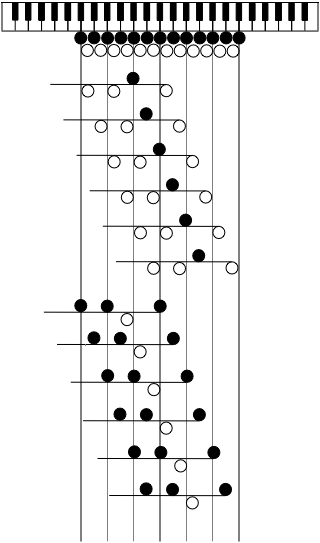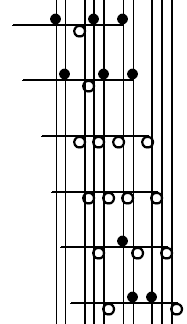There has been some recent discussion in the MNMA forum about an alternative version of Klavarskribo that its inventor (Cornelis Pot) had designed for chromatic, 6-6 keyboards (i.e. keyboards having 6 white keys and 6 black keys in each octave, as opposed to 7 white keys and 5 black keys). Below is my attempt at reconstructing an image from a verbal description (posted in the forum) of an image that was published in a Dutch article in the February 1972 issue of Klavar-Nieuws:
Image may be NSFW.
Clik here to view.
The above example contains all 12 major triads (with doubled roots), traversing over them in two sequences that correspond to the two whole-tone scales. As you can see, there are just two keyboard patterns to learn. (With a Janko keyboard that has more than just two rows of keys, then there’s really just one keyboard pattern to learn. To move up a half step, you’d just shift from the first and second rows to the second and third rows, keeping your hand in the same position.) A comparison with the Klavarskribo equivalent for the traditional piano keyboard shows just how irregular the traditional keyboard is, and how many patterns you have to learn within those same 12 keys (for chords, scales, etc.).
Below are the first six chords (in regular Klavarskribo notation), corresponding to the whole-tone scale starting on C. One thing that was apparently not made explicit in the Klavar-Nieuws article was which key is indicated by the thicker vertical lines in the 6-6 notation above. In my transcription to regular Klavarskribo, I just chose a mapping: B for the thicker lines so that C lands just to the right of each thicker vertical line in the 6-6 notation. Thus, the first sequence would then start with the C-Major chord:
Image may be NSFW.
Clik here to view.
And here’s the second sequence, traversing the whole-tone scale starting on D-flat:
Image may be NSFW.
Clik here to view.
As you can see, there’s nothing in these sequences that approaches the regularity of the 6-6 keyboard patterns. There’s a lot to discuss in comparing the two keyboard layouts—enough to leave for another blog post.
The message in the MNMA forum that described the 6-6 Klavar notation contained lots of fascinating insights, along with quotes relating to the 6-6 keyboard from a letter written by Pot. I wish I could link to it directly. The problem is that the MNMA forum messages are currently only accessible to members (although anyone can join). That may (hopefully) change in the near future and in fact is being discussed on the list right now.
